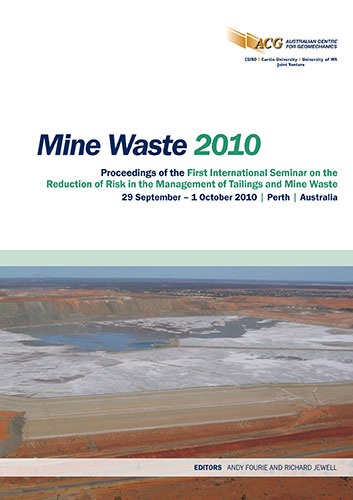In situ foundation improvement for upstream raising of embankments using dried tailings

|
Authors: Smirk, DD; Jackson, S |
DOI https://doi.org/10.36487/ACG_rep/1008_22_Smirk
Cite As:
Smirk, DD & Jackson, S 2010, 'In situ foundation improvement for upstream raising of embankments using dried tailings', in R Jewell & AB Fourie (eds), Mine Waste 2010: Proceedings of the First International Seminar on the Reduction of Risk in the Management of Tailings and Mine Waste, Australian Centre for Geomechanics, Perth, pp. 251-260, https://doi.org/10.36487/ACG_rep/1008_22_Smirk
Abstract:
The use of upstream construction methods on tailings dams is a common method of increasing the capacity of an earthen tailings dam. However, as this technique involves construction over existing tailings deposits, foundation strength is critical to ensure that the long-term integrity and stability of the wall can be achieved for single or multiple upstream raising campaigns. For low-strength tailings the conventional approach is to import materials such as rock fill for placement as a bridging layer in the construction area. This proven approach will successfully deliver the required foundation strength improvement. However, suitable rock fill is normally a premium product and hence provides this solution at a high capital cost. Recently, the authors have completed investigations into processes to improve the foundation strengths at several tailings dams within the alumina industry. The fundamental approach has been to identify tailings dewatering processes that can be applied to alumina tailings (bauxite residue) such that equivalent foundation strengths can be developed in realistic timeframes. Investigations have concentrated around developing techniques using the MudMaster (twin archimedes screw tractor or amphirol) in combination with conventional earthmoving equipment (swamp dozers/ excavators) to accelerate the dewatering process. These techniques are usually incorporated into the operations of the tailings dam and hence these improvements form part of normal operating costs. Dried tailings from the operational (active) areas can then be used to construct part of the upstream raise (usually zoned within the embankment cross section). Although the techniques employed need to be tailored to an operating site (based on climatic conditions, production rates etc.) the fundamental principles remain consistent. Foundation strength improvements from <5 kPa to well above 30 kPa within 90 days have been achieved with net capital savings over A$ 1 million per site compared to convention construction methods using dumped rock and imported materials. After success at several locations, the authors have developed a simplified foundation improvement method that can be applied almost anywhere. This paper will detail the general dewatering techniques developed, the foundation strength improvements achieved and the costs to achieve this improvement.
References:
Cooling, D.J. (2006) Improving the Sustainability of Residue Management Practices – Alcoa World Alumina Australia,
in Proceedings Tenth International Seminar on Paste and Thickened Tailings (Paste07), A.B. Fourie and R.
Jewell (eds), 13–15 March 2007, Perth, Australia, Australian Centre for Geomechanics, Perth, pp. 3–16.
In situ foundation improvement for upstream raising of embankments using dried tailings D.D. Smirk and S. Jackson
260 Mine Waste 2010, Perth, Australia
Cooling, D.J., Hay, P.S. and Guilfoyle, L. (2002) Carbonation of Bauxite Residue, in Proceedings 6th International
Alumina Quality Workshop, 8–13 September, 2002, Brisbane, Australia, pp. 185–190.
Power, G., Gräfe, M. and Klauber, C. (2009) Review of Current Bauxite Residue Management, Disposal and Storage:
Practices, Engineering and Science, CSIRO National Research Flagships – Light Metals, DMR-3608, May 2009.
© Copyright 2025, Australian Centre for Geomechanics (ACG), The University of Western Australia. All rights reserved.
View copyright/legal information
Please direct any queries or error reports to repository-acg@uwa.edu.au
View copyright/legal information
Please direct any queries or error reports to repository-acg@uwa.edu.au